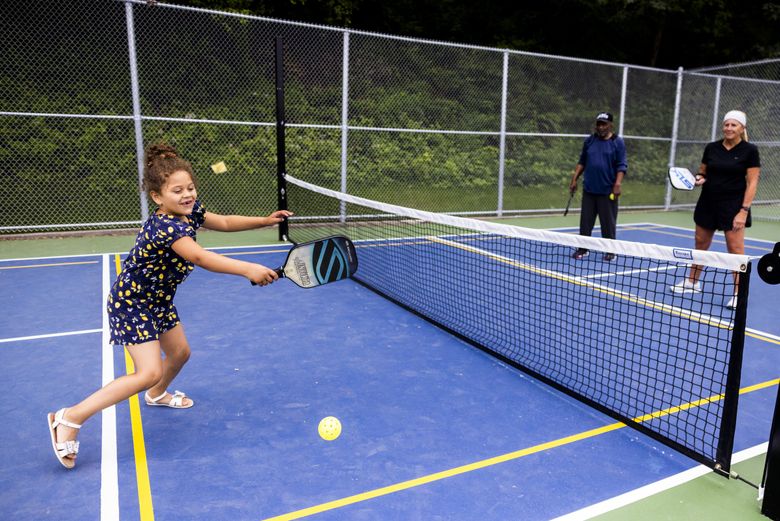Transform Your Outdoor Room: How to Design and Develop Pickleball Judiciaries in Your Residential Backyard
Producing a pickleball court in your yard not just includes worth to your building but also offers an one-of-a-kind possibility for recreation and social interaction. Understanding the vital measurements, site choice, and product options is vital for an effective installment. In addition, the layout and construction procedure can significantly impact the usability and enjoyment of the court. As you think about these aspects, you'll discover that thoughtful planning is key to achieving a visually appealing and functional room that welcomes both play and neighborhood interaction. What might be the primary steps in this transformative journey?

Recognizing Pickleball Court Dimensions
When beginning on the trip to make a pickleball court in your backyard, it's important to realize the specific measurements that define an official court. An official pickleball court gauges 20 feet vast and 44 feet long for both singles and doubles play. In addition, the court is divided into two equal halves by a centerline expanding from the standard to the non-volley area, which lies 7 feet from the web on both sides.
The web itself stands at 36 inches high at the sidelines and 34 inches high at the facility, ensuring a consistent playing experience. Surrounding the court, a minimum of 3 feet of buffer space is recommended on all sides to accommodate player movement and to stop injuries during gameplay.
For optimal performance, consider incorporating proper surface products and ample water drainage remedies when intending your court. The alignment of the court need to additionally be considered to lessen sunshine disturbance during peak playing hours. Comprehending these dimensions is vital as they will certainly lead the construction procedure and ensure that your yard pickleball court satisfies official requirements for leisure play.
Selecting the Right Place
Picking an appropriate location for your backyard pickleball court is crucial to making best use of both pleasure and performance. The ideal website ought to use a flat, level surface area to make sure proper water drainage and lessen maintenance obstacles. Preferably, a space of at the very least 30 feet broad and 60 feet long will fit the court dimensions while giving space for safe motion around the playing area.
Take into consideration the positioning of the court in relation to the sunlight. Placing the court east-west can aid reduce glow during play, as gamers will encounter the sun throughout morning or late afternoon suits. Furthermore, bear in mind any bordering structures, such as trees or fences, which may block play or cause disturbances.
Ease of access is an additional essential variable; the court should be quickly obtainable from your home for convenience and celebrations. Ensure there suffices room for seating and spectator areas, boosting the enjoyment for good friends and family alike. Inspect regional laws or neighborhood guidelines to make sure conformity with zoning regulations and potential licenses, which can influence your task's feasibility. By carefully choosing the place, you will certainly develop a pleasurable and practical pickleball court for several years ahead.
Selecting Appropriate Materials
The choice of products is extremely important in the building and construction of a yard pickleball court, as it straight impacts upkeep, sturdiness, and playability. When selecting products, it is essential to YOURURL.com take into consideration both the surface and the surrounding framework.
For the playing surface, alternatives such as concrete, asphalt, or specialized sports floor tiles are frequently made use of. Concrete offers superb toughness and a consistent playing surface area, while asphalt can be a more economical alternative.
In terms of bordering infrastructure, fence is crucial for keeping the round within play and maintaining privacy. Chain-link fence is one of the most popular option, supplying visibility while offering essential control. Additionally, think about making use of weather-resistant materials for benches and other accessories to make sure long life.
Ultimately, the selection of proper products need to align with your budget, aesthetic preferences, and certain having fun problems. Buying quality materials will not only improve gameplay however likewise minimize lasting upkeep prices, permitting years of enjoyment in your backyard pickleball court.
Designing Your Court Layout
After establishing the best materials for your pickleball court, the next step involves very carefully preparing the court design to maximize both capability and enjoyment. Begin by selecting an appropriate location in your backyard, considering elements such as sunlight, wind instructions, and distance to other outside functions. Guarantee there is sufficient space not only for the court itself yet additionally for surrounding safety zones.
A standard pickleball court measures 20 feet vast by 44 feet long for both songs and increases play. It is recommended to add added room around i thought about this the court-- ideally, at least 10 feet on all sides-- to allow for gamer activity and to avoid accidents. Marking the court measurements precisely is important; utilize chalk or string to lay out the location before any kind of building starts.
Integrate optimal watching angles, particularly if you intend to amuse guests throughout games. In addition, think about the positioning of benches or seating areas close by for players and viewers to rest. Thoughtful format planning will certainly create a welcoming and functional atmosphere that enhances the general experience of playing pickleball in your backyard.
Step-by-Step Construction Refine
Structure a backyard pickleball court involves a methodical building procedure that ensures durability and optimum playability. The very first step is to prepare the site by getting rid of any plants, rocks, or particles and leveling the ground. Once the location is prepped, detail your court dimensions-- 20 feet large by 44 feet long for increases play-- using stakes and string.
Next, excavate the location to a deepness of about 4-6 inches, making certain correct water drainage is included. Following this, put a concrete piece, enabling for a smooth and level surface, which is vital for consistent ball bounce.

Final Thought
To conclude, the transformation of a property backyard into a pickleball court uses significant leisure advantages. By adhering to official measurements and picking a suitable place, people can develop a welcoming space for leisure and community interaction. The selection of sturdy products, thoughtful layout, and correct building and construction techniques further enhance the functionality and longevity of the court. Eventually, this venture promotes a vivid setting for family and buddies to delight in the growing sporting activity of pickleball.

Picking an appropriate location for your backyard pickleball court is important to maximizing both enjoyment and functionality.After establishing the best materials for your pickleball court, the next step includes very carefully intending the court layout to optimize both capability and satisfaction.Building a backyard pickleball court includes a methodical construction procedure that makes certain sturdiness and ideal playability.